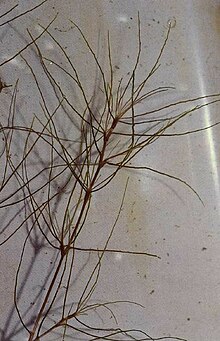| Najas guadalupensis | |
|---|---|

| |
| Scientific classification | |
| Kingdom: | Plantae |
| Clade: | Tracheophytes |
| Clade: | Angiosperms |
| Clade: | Monocots |
| Order: | Alismatales |
| Family: | Hydrocharitaceae |
| Genus: | Najas |
| Species: | N. guadalupensis
|
| Binomial name | |
| Najas guadalupensis | |
| Subspecies[2] | |
| |
| Synonyms[2] | |
|
List
| |
Najas guadalupensis is a species of aquatic plant known by the common names southern waternymph,[3] guppy grass, najas grass, and common water nymph. It is native to the Americas, where it is widespread. It is considered native to Canada (from Alberta to Quebec), and most of the contiguous United States, Mexico, Central America, the West Indies and South America. It has been introduced in Japan, and Palestine and Israel.[4]
Najas guadalupensis is an annual, growing submerged in aquatic habitat types such as ponds, ditches, and streams. It produces a slender, branching stem up to 60 to 90 centimeters in maximum length. The thin, somewhat transparent, flexible leaves are up to 3 centimeters long and just 1 or 2 millimeters wide. They are edged with minute, unicellular teeth. Tiny flowers occur in the leaf axils; staminate flowers grow toward the end of the plant and pistillate closer to the base.[5][6][7] They are also a popular aquarium plant for beginners due to their hardiness as well as growth rate, which helps provide shelter for aquarium fish.[8][9]
- ^ Maiz-Tome, L. (2016). "Najas guadalupensis". IUCN Red List of Threatened Species. 2016: e.T177124A1467909. doi:10.2305/IUCN.UK.2016-1.RLTS.T177124A1467909.en. Retrieved 19 November 2021.
- ^ a b "Najas guadalupensis (Spreng.) Magnus". Plants of the World Online. Royal Botanic Gardens, Kew. Retrieved 18 October 2024.
- ^ USDA, NRCS (n.d.). "Najas guadalupensis". The PLANTS Database (plants.usda.gov). Greensboro, North Carolina: National Plant Data Team. Retrieved 16 July 2015.
- ^ "Najas guadalupensis in Flora of North America @ efloras.org". www.efloras.org. Retrieved 2017-01-31.
- ^ Magnus, Paul Wilhelm. 1870. Beitrage zur Kenntniss der Gattung Najas viii. Najas guadalupensis
- ^ von, Linné, Carl; von, Linné, Carl; Christian, Dieterich, Johann; Anton, Sprengel; Anton, Sprengel; Joachim, Sprengel, Kurt Polycarp; Dieterichianae., Librariae (1825-01-01). "Caroli Linnaei ... Systema vegetabilium /". v.1 (1825).
{{cite journal}}: Cite journal requires|journal=(help)CS1 maint: multiple names: authors list (link) - ^ Subils, Rosa & Hunziker, Armando Theodoro. 1973.Lorentzia no. 2: 9, fig. 1, Najas arcana
- ^ Maerz, John C.; Wilde, Susan B.; Terrell, Vanessa K.; Haram, Brigette; Trimmer, R. Clay; Nunez, Chelsea; Cork, Erin; Pessier, Allan; Lannoo, Sue; Lannoo, Michael J.; Diamond, Sara L. (2018-11-01). "Seasonal and plant specific vulnerability of amphibian tadpoles to the invasion of a novel cyanobacteria". Biological Invasions. 21 (3): 821–831. doi:10.1007/s10530-018-1861-6. ISSN 1387-3547. S2CID 53198641.
- ^ "Aquarium Guppy Grass (Najas Guadalupensis) - Benefits And Care". 2020-12-07. Retrieved 2022-04-30.
